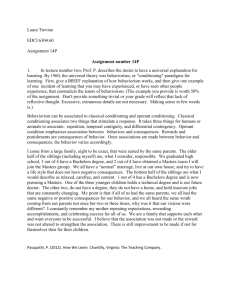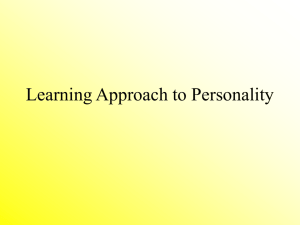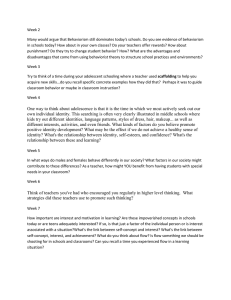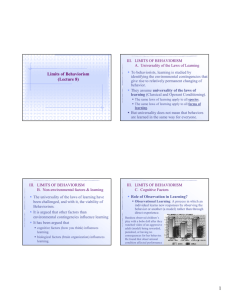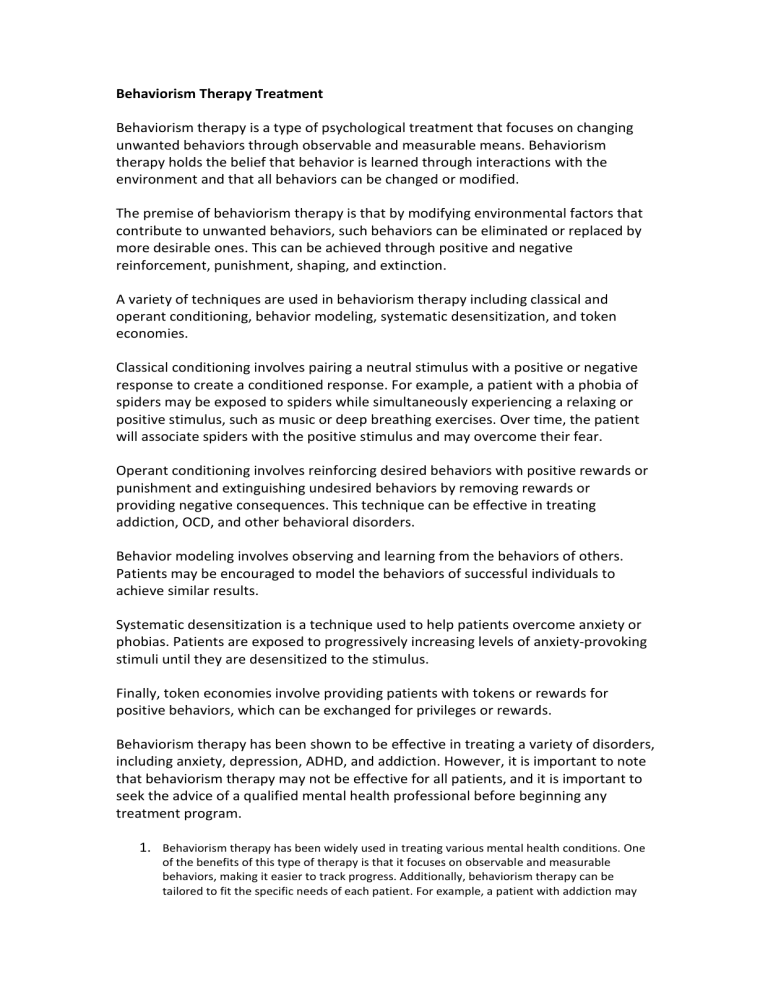
Behaviorism Therapy Treatment Behaviorism therapy is a type of psychological treatment that focuses on changing unwanted behaviors through observable and measurable means. Behaviorism therapy holds the belief that behavior is learned through interactions with the environment and that all behaviors can be changed or modified. The premise of behaviorism therapy is that by modifying environmental factors that contribute to unwanted behaviors, such behaviors can be eliminated or replaced by more desirable ones. This can be achieved through positive and negative reinforcement, punishment, shaping, and extinction. A variety of techniques are used in behaviorism therapy including classical and operant conditioning, behavior modeling, systematic desensitization, and token economies. Classical conditioning involves pairing a neutral stimulus with a positive or negative response to create a conditioned response. For example, a patient with a phobia of spiders may be exposed to spiders while simultaneously experiencing a relaxing or positive stimulus, such as music or deep breathing exercises. Over time, the patient will associate spiders with the positive stimulus and may overcome their fear. Operant conditioning involves reinforcing desired behaviors with positive rewards or punishment and extinguishing undesired behaviors by removing rewards or providing negative consequences. This technique can be effective in treating addiction, OCD, and other behavioral disorders. Behavior modeling involves observing and learning from the behaviors of others. Patients may be encouraged to model the behaviors of successful individuals to achieve similar results. Systematic desensitization is a technique used to help patients overcome anxiety or phobias. Patients are exposed to progressively increasing levels of anxiety-provoking stimuli until they are desensitized to the stimulus. Finally, token economies involve providing patients with tokens or rewards for positive behaviors, which can be exchanged for privileges or rewards. Behaviorism therapy has been shown to be effective in treating a variety of disorders, including anxiety, depression, ADHD, and addiction. However, it is important to note that behaviorism therapy may not be effective for all patients, and it is important to seek the advice of a qualified mental health professional before beginning any treatment program. 1. Behaviorism therapy has been widely used in treating various mental health conditions. One of the benefits of this type of therapy is that it focuses on observable and measurable behaviors, making it easier to track progress. Additionally, behaviorism therapy can be tailored to fit the specific needs of each patient. For example, a patient with addiction may benefit from operant conditioning techniques while a patient with anxiety may benefit from systematic desensitization. 2. 3. It is important to note that behaviorism therapy is not a one-size-fits-all solution and may not work for everyone. It is crucial for patients to seek the guidance of a qualified mental health professional before starting any treatment program. Furthermore, behaviorism therapy should not be viewed as a replacement for other forms of treatment such as medication or talk therapy but rather as an additional tool in the treatment arsenal. 4. Overall, behaviorism therapy has shown promising results in helping patients overcome unwanted behaviors and improve their quality of life. With proper guidance and support, patients can learn new skills and techniques to manage their symptoms and achieve lasting change. How operant conditioning can be used to treat mental health patient, with references? 1. Systematic Desensitization: This technique is used to treat anxiety disorders and phobias. The patient is gradually exposed to the feared object or situation in a safe and controlled environment, while simultaneously learning relaxation techniques. 2. Token Economy: This approach is commonly used in psychiatric hospitals and residential treatment facilities. Patients are rewarded with tokens for positive behaviors, which can then be exchanged for privileges or rewards. 3. Contingency Management: This technique involves providing tangible rewards for desired behaviors, such as drug abstinence or attendance at therapy sessions. 4. Behavioral Activation: This approach focuses on increasing engagement in positive activities to improve mood and decrease symptoms of depression. 5. Cognitive Restructuring: This technique aims to identify and challenge negative thought patterns that contribute to mental health disorders, and replace them with more adaptive thoughts. References: - Kazdin, A.E. (2007). Behavior Modification in Applied Settings (6th ed.). Belmont, CA: Wadsworth. - Beck, J.S. (2011). Cognitive Behavior Therapy: Basics and Beyond (2nd ed.). New York: Guilford Press. - Linehan, M.M. (1993). Skills Training Manual for Treating Borderline Personality Disorder. New York: Guilford Press. - Higgins, S.T., Silverman, K., & Heil, S.H. (2008). Contingency Management in Substance Abuse Treatment. New York: Guilford Press. - Wolpe, J., & Lazarus, A.A. (1966). Behavior Therapy Techniques: A Guide to the Treatment of Neuroses. New York: Pergamon Press. Continuation: 6. Positive Reinforcement Training - this method involves rewarding patients when they exhibit desirable behaviours or traits using praise or tangible items such as treats or gifts. 7. Exposure Therapy - this type of therapy involves exposing patients to stimuli that trigger their anxiety or fear responses under controlled conditions until they become desensitized to the stimuli. 8. Response Prevention - this method aims at preventing patients from engaging in compulsive behaviours by teaching them alternative ways of responding to their triggers. 9. Social Skills Training - this approach helps patients learn how to interact positively with others by teaching them effective communication skills and social cues. 10.Behavioural Contracting - this technique is used when treating patients who have difficulty sticking with treatment plans; it involves creating a written agreement between the patient and therapist outlining specific goals and rewards for achieving them. References: - Foa EB & Rothbaum BO (1998) Treating the Trauma of Rape Cognitive-Behavioral Therapy for PTSD -Goldfried MR & Davison GC(1994) Clinical behavior therapy -Sperry L.(2005)Behavioral interventions in cognitive behavior therapy -Marder SR et al.(2003)Treatment of schizophrenia with psychosocial therapies -Rathus JH et al.(1979)Behavior Therapy Techniques References: 5. Cherry, K. (2021). Behaviorism and Behavior Therapy. Verywell Mind. 6. 7. https://www.verywellmind.com/what-is-behaviorism-2794852 McLeod, S. A. (2018). Behaviorist Approach. Simply Psychology. https://www.simplypsychology.org/behaviorism.html National Alliance on Mental Illness. (2019). Types of Therapy. https://www.nami.org/learnmore/treatment/types-of-therapy
